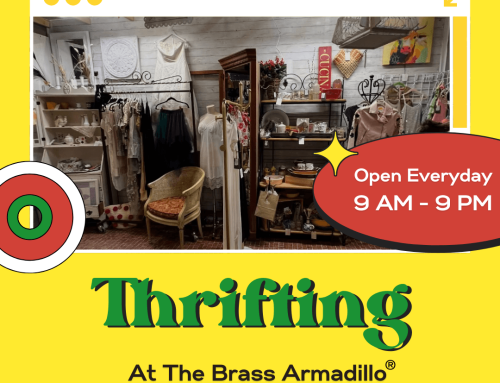Antiques are officially the world’s 749th most traded product in a given year, with a total trade worth of around $1.72 billion. In the new millennium, the buzzword is sustainability, and antiques fit right in with the penchant for reusing, recycling, and even upcycling. Most varied fine jewelry collections contain at least one or more antique or vintage pieces. Contemporary pieces are great for every day, but when it comes to gala events or special outfits that stand out from the rest, antiques definitely have an important role to play. If you are keen on expanding your current collection with a few historical pieces, whether they’re from one of our Brass Armadillo Antique Mall locations or another antique store, make sure to get value for your money by keeping the following tips in mind for where and how to find authentic vintage and antique jewelry.
Determining Authenticity
If you are investing in a fine piece of antique jewelry, having your pieces valued by a specialist is vital, as there is a myriad of copies of pieces hailing from specific historical periods—including the Edwardian and Victorian periods. If you aren’t after pieces from a particular era, watch out for telltale signs that the piece dates back to at least the 1900s. Detailed, lacy filigree work was popular in the Edwardian period, while hand-cut gems (such as rose-cut diamonds) were all the rage among sartorial people from the Victorian and Georgian periods.
Watching Out for Modern Materials
Some materials are known to have been invented or to have become popular in the 1900s. These include palladium (a whitish/silvery metal that first gained popularity in the 1930s) synthetic plastics, glass, and rhinestones. These materials burst on the scene with Ela Schiaparelli’s costume jewelry designs.
Prioritizing Jewelry with Personal Meaning
If you decide to incorporate antique and vintage jewelry items into your collection, ensure you that, wherever you find them, you choose wearable pieces that you will enjoy donning every day or for social events. Your antique jewelry collection does not have to be made of large, expensive gemstones, intricate engravings, or complicated settings. For instance, one of this summer’s hottest jewelry trends, hoop earrings, is a simple yet appealing design that never goes out of style. The history of these joyful earrings dates back to around 2500 BCE, when they were worn in the area that is known today as Sudan. In 150 BCE, hoops were popular among Egyptian women and men, who believed that they enhanced their wearer’s beauty. They were also favored in the 1820s, when big, Roman-style hoops held sway. Today, this earring style is considered symbolic of empowerment and unity. If these values resonate with you, look for an antique pair that will bring you back to past elegance while also marking you as a lover of contemporary fashion and accessories.
Check for the Jeweler’s Mark
Antique jewelers nearly always left a mark to indicate the piece was designed by them. This is a good tip for how to find authentic antique and vintage jewelry pieces. This mark could comprise initials, a signature, or a symbol. These marks give buyers vital information about matters such as the identity of the manufacturer, the date of the piece’s creation, the country of origin, and how many copies exist. There are websites that are dedicated to explaining the meaning of various marks you might find in antique or vintage pieces. Take the time to check them out to ensure your chosen pieces are old enough to be considered antiques.
Be On the Lookout for Pieces with Patina
Patina is the beautiful dark sheen that appears on metal pieces after various years of use. If a design is an authentic antique, then chances are, it has been used frequently and it should therefore bear a little ‘attractive tarnishing’ as well as dents and a lack of shine (unlike brand-new pieces). Sometimes, antique sellers restore items so they dazzle with brightness. If so, as a tip for how to find authentic antique and vintage jewelry, make sure the piece you’re eyeing is an authentic restoration instead of a well-designed faux design.
Avoid Items That Are Too Good to Be True
Antique jewelry that is in good condition and that is made with precious gemstones like emeralds, rubies, diamonds, and precious metals can be worth several times more than modern designs. Their price is dependent on characteristics such as rarity, detailing, and cut. For instance, authentic Victorian-era filigree is known for its delicate, intricate patterns. The uniqueness of each piece is a key consideration as well. Features such as original art nouveau settings, the presence of intricately cut gems, and an appealing warm glow in the metal all raise an item’s value. Finally, wherever you find antique jewelry pieces, know that name-brand designers seriously up the price of any vintage piece. Antique items by Tiffany, Van Cleef & Arpels, or Cartier are fought over in prestigious auctions across the globe. If the piece you are interested in seems like a ‘bargain’, it probably isn’t authentic. Anyone with such a piece probably knows better than to lower its price to make a quick sale since these pieces always sell well at auctions and in private sales.
Antique jewelry is more popular than ever, with younger generations feeling that these pieces resonate strongly with their values. If you are investing in an heirloom piece, make sure to get the item valued by a professional. Know where to find and how to identify authentic antique and vintage jewelry pieces, look out for telltale signs of a good investment, including special marks, a pretty patina, and hand-cut gems with a special sparkle and purity.
Guest Blog provided by:
Jacqueline Gilbert







